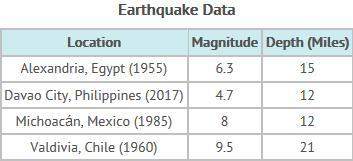
This table compares magnitude and depth of four earthquakes occurring between 1955 - 2017. the surface changes that occur as a result of earthquakes begin in earth's crust. what conclusion can be drawn about earthquake activity within earth's crust based on the data shown?
a) earthquake depth has continuously increased throughout the past century.
b) higher-magnitude earthquakes do not always happen deeper in earth's crust.
c) the higher an earthquake's magnitude, the deeper in earth's crust it occurs.
d) earthquake magnitude has continuously decreased throughout the past century.


Answers: 2
Other questions on the subject: Chemistry

Chemistry, 21.06.2019 16:00, latoyatuggle23
Endeleev saw trends in the physical and chemical properties of elements when he organized them by
Answers: 2

Chemistry, 21.06.2019 20:30, jaejaeJae9534
Which of the following true? a_volcanoes and earthquakes often near the plate boundaries. b_volcanoes occur whereve there are tall mountains. c_earthquakes cause volcanoes in the same location to erupt violently d_volcanoes and earthquakes occur only where plates are colliding with each other
Answers: 2

Chemistry, 22.06.2019 14:00, njones58emailtjcedu
What mass of natural gas (ch4) must you burn to emit 276 kj of heat?
Answers: 1

Chemistry, 22.06.2019 17:30, destineysarah
98 points you will be galileo perform the experiment to determine if objects with different mass fall at the same, or different, rates in the air and in a vacuum. before you conduct your experiment, you need to form a hypothesis. a hypothesis is a prediction of what you think will happen in the experiment. the hypothesis is a statement that describes “if” a certain set of circumstances are present “then” there will be a specific result that will occur. record your hypothesis here: record the results from step one of the experiment (dropping the objects in the air): first trial: second trial: third trial: record the results from step two of the experiment (dropping the objects in a vacuum): first trial: second trial: third trial: did the experiment support your hypothesis? using the data from your experiment, describe why you believe your hypothesis was either proven or disproven. what forces were acting on the objects dropped in the air? what force was acting on the objects dropped in the vacuum? part two: comparing forces choose two forces and compare and contrast these forces. you must provide two ways that they are alike and two ways that they are different. you may make a list, write in paragraph form, or make a chart. choose two forces and compare and contrast these forces. these must be different forces than used in the prior question. provide two ways that they are similar and two ways that they are different. you may make a list, write it out, or make a chart.
Answers: 3
Do you know the correct answer?
This table compares magnitude and depth of four earthquakes occurring between 1955 - 2017. the surfa...
Questions in other subjects:


English, 03.04.2021 21:30


Geography, 03.04.2021 21:30


Geography, 03.04.2021 21:30










